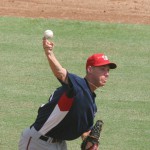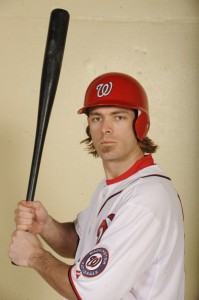
Taylor Jordan is making a case for his future with this organization. Photo via wffn.net/hueytaxi on flikr.com
I’ll file this as one of the “Patently Obvious” responses that have come out of Mike Rizzo‘s mouth in response to a reporter’s question, but Rizzo went “on record” as saying that Taylor Jordan will “get every opportunity to be in the mix for the rotation next year” per beat reports (this example from Byron Kerr) after Jordan got his first major league victory in Sunday 7/28/13’s 14-1 blow-out of the Mets.
Well, of course he’ll get a chance to compete for the rotation. He’s pitching a hell of a lot better right now than $13M man Dan Haren, for approximately 1/30th of the cost. What GM doesn’t want that??
One of the big reasons I started this blog was to talk about the development of Nats minor league pitchers. Back in the dark days, when the team was spending $15M on the FA market to acquire 5th starters like Jason Marquis, I became convinced that the single most valuable commodity in Major League Baseball (in terms of talent development and acquisition) was the pre-arbitration starting pitcher. Our farm system had the “Loria/Bowden” holes in terms of player development in the 2007-2009 time frame and for a few years the team couldn’t develop an effective starter, instead relying on guys like Marquis and on other minor league/low-end free agent signings (think Tim Redding, Daniel Cabrera, and the aging Livan Hernandez being examples). Rizzo came in, put the emphasis on drafting and development, and now the opening day rotation features 3 home-grown guys and a fourth in Gio Gonzalez who was acquired by trading other home-grown guys.
One of my biggest data-collection projects was the information behind my regular “Pitcher Wins on the Free Agency Market” post. After looking at pretty much every significant FA pitcher signing that baseball has ever had, and calculating salary versus wins, it became clear that teams are historically doing well if they get about one win per $1M spent on a FA pitcher. Sign a guy for $13M a year? You hope to get 13 wins out of him.
But this analysis also shows just how valuable the pre-arbitration, cost-controlled starter is. Consider Clay Buchholz for Boston in 2010; he goes 17-7 in his 3rd active year, earning the MLB minimum of $443,000. That 17-win capability eventually earned him a $12-$13M/year contract, but while he was getting the minimum he was winning games for Boston for pennies on the dollar versus what it would have cost Boston to purchase that capability on the open market.
Combine this point with the continually dwindling talent available on the FA market these as teams lock up their players earlier and more frequently, and the price for pitching just continues to go higher. Zack Greinke signed a 6 year $147M contract paying him more than $24M annually last summer partly because he was the only significant pitcher out there. Grienke is talented, don’t get me wrong, but outside of his unbelievable 2009 season he’s basically pitched like a #3 starter. Even this year, he’s pitching to a rather pedestrian 103 ERA+, just barely above the league average of adjusted ERA for starters. Not exactly what you expect for that kind of money. The 2014 Free Agent Market in terms of pitching is looking equally as bare as 2013. The best guy out there may be Matt Garza, who again is talented but is also injury prone and not exactly a league-wide Ace. Get past Garza and you’re looking at inconsistent (Ricky Nolasco or Phil Hughes), injury plagued (Shawn Marcum or Colby Lewis), just old guys (Freddy Garcia, Hiroki Kuroda) and pure wild cards (Tim Lincecum or Scott Kazmir).
There’s a reason Tampa went nearly 8 full seasons without having a Free Agent acquisition start a game for them; they know exactly what it means to develop effective starters, and they have a stableful of them. Trade away James Shields and Wade Davis? No problem; just call up Chris Archer and Alex Colome (never mind the rest of their Durham rotation).
So, back to Jordan. If the Nats can find an effective 4th or 5th starter from their farm system right now, it frees them from the one-year hired gun strategy of Haren and Edwin Jackson. It gives them the flexibility to continue to allow their best prospects in the lower minors to develop (i’m thinking specifically of A.J. Cole, Robbie Ray, Sammy Solis, and Matthew Purke, though Cole and Ray aren’t exactly in the “low” minors anymore with their promotions to AA). It gives them the depth they did not have this year to cover for a starting pitcher injury. It gives them time to let Nathan Karns figure out if he’s going to be a starter or a reliever at the MLB level. It gives them added payroll flexibility can go towards fixing holes in the short term. Longer term it allows the team to spend money on extending the core guys, or allows them to consider whether the rising price tag on someone like Ross Detwiler is worth paying (much like they cut loose John Lannan last year). If you’re going to pay market value for Strasburg and Harper, then you’re going to need some low-cost players who can contribute to counter balance the payroll.
Or, and it wouldn’t surprise me to see this either, it gives Rizzo interesting trade chips that he could package with other guys to acquire the Haren/Jackson hurler instead of buying him.
Two years ago we acquired Gonzalez for two near-to-the-majors starters, a surplus catcher prospect and a low-minors/high profile arm. Right now it seems like we could put nearly the same package together (Jordan, Karns, Jhonatan Solano or Sandy Leon and then a decent arm from A-ball, or maybe even a Ray or Cole) and move them for such a resource. I wouldn’t put it past Rizzo; Jordan may be looking good right now, but his peripherals don’t project as a “Rizzo Guy.” Neither did Tommy Milone so he got shipped out; will Jordan be a 5th starter candidate in 2014 or trade bait?
Personally, I’d like to see Jordan succeed. He’s a great success story; unhearalded 9th rounder coming off an injury that most of us thought was good, but who also thought that finishing the year successfully at high-A would have been a great achievement. Instead he blows through high-A and AA ball and is now more than holding his own in the majors.

